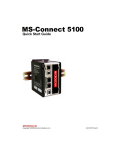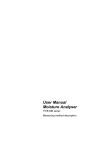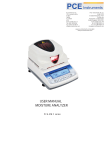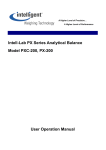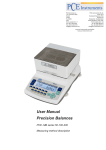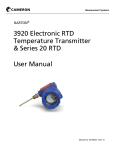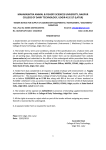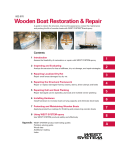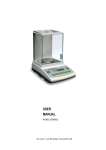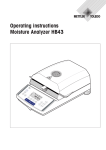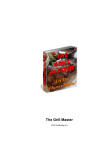Download moisture analyzer white paper
Transcript
_____________________________________________________________________________________ Moisture content is a quality control criterion signifying the amount of moisture in a product. Laws as well as industry trade associations define the correct moisture content for a broad range of products including pharmaceuticals, plastics, wood chips, fabrics, paint, body lotion, seeds, tobacco, potting soil, dried fruits and vegetables, catsup, grains…..etc. More than quality is involved. For products sold by weight too much moisture means the customer is paying for water instead of product. If moisture content is below spec more is required to fill the package and the vendor takes the hit. Ascertaining the amount of moisture in a sample is accomplished with a moisture analyzer. These devices calculate moisture content in several ways, one of the most common being the thermogravimetric method or loss of weight on drying (LOD). The LOD process equates to the amount of moisture removed by evaporation when the sample is heated. Simply stated, a thermogravimetric moisture analyzer pairs a scale with a heater. This white paper will help you understand moisture analyzers – a.k.a. moisture balances – by explaining their components, how they work and specification criteria. But if you have any questions our scientists are ready with the answers. Tovatech LLC Phone (973) 913-9734 [email protected] 11 Harrison Court, South Orange, NJ 07079 _____________________________________________________________________________________ So, What is Moisture? This is an excellent question. A moisture balance measures anything that evaporates on heating. In addition to water this may include fats, oils, alcohol and solvents. If it adheres to the sample surface it can be termed adhesive, free water or hygroscopic moisture. Moisture absorbed by a material is called absorbed or equilibrium moisture. Water can also be chemically bonded at the molecular level, in which case it is called water of crystallization or hydrated water. In this case the moisture is called bonding moisture or combined water. Tip: Certain volatile substances may be given off during a moisture analysis. Procedures should be in place to take these into account. Do not perform analyses on explosive or flammable materials or those that become hazardous on heating. Tovatech LLC Phone (973) 913-9734 [email protected] 11 Harrison Court, South Orange, NJ 07079 _____________________________________________________________________________________ How do Moisture Analyzers Work? It is a 3-step procedure. Parameters of the drying process are entered on a keypad. The sample is placed in a drying chamber, and the analysis begins. The instrument calculates the moisture content by comparing the initial weight of the sample to the weight after drying is complete. Tovatech LLC Phone (973) 913-9734 [email protected] 11 Harrison Court, South Orange, NJ 07079 _____________________________________________________________________________________ What are the Components of a Moisture Balance? As noted above the unit is comprised of a heater mounted on anprecision balance equipped with a control panel and display. Other components include a sample pan holder and sample pans. Fiberglass filters are available to either cover or sandwich samples to improve heat absorption, avoid splashing or protect them from developing a film or crust during the heating process. Moisture balances with a memory function allow researchers to build a library of frequently used analysis programs. An RS 232 interface connects to computers or printers for record keeping. Tovatech LLC Phone (973) 913-9734 [email protected] 11 Harrison Court, South Orange, NJ 07079 _____________________________________________________________________________________ You Mentioned Display. What is Displayed? Backlit LCDs provide a wealth of information, the extent of which depends on the particular model. Examples include current weight, current moisture content in %, the drying mode (see below), the switch-off mode (see below), the previous drying time, the current temperature, and an indicator that the drying process is active. As suggested above data can be transferred via an RS232 interface to a printer or computer for record keeping. Units are available with software delivering a real-time graphic display of the moisture loss profile to your computer. Tovatech LLC Phone (973) 913-9734 [email protected] 11 Harrison Court, South Orange, NJ 07079 _____________________________________________________________________________________ How is Heat Applied to Samples? Halogen or infrared heaters are commonly used. These are mounted on precision balances. The instrument can be programmed to conduct the analysis in accordance with procedures recommended by industry trade associations and government agencies. As to the difference, halogen is much faster. Temperature is generally maintained within 1⁰C of the selected setting. While most analyses involve increasing the temperature to a maximum of 160⁰C or less, in special cases higher temperatures may be necessary to achieve complete drying. Note that there are other methods including microwave and the Karl Fischer method. Microwave drying instruments are somewhat larger and significantly more expensive than halogen-heated moisture analyzers. The Karl Fischer titration method, while accurate, uses hazardous solvents, requires skilled technicians and that the water in the sample be accessible to the reagent in order for the method to work. The method detects only water, whereas thermogravimetric analyzers detect any volatile substance in the sample. Tovatech LLC Phone (973) 913-9734 [email protected] 11 Harrison Court, South Orange, NJ 07079 _____________________________________________________________________________________ What are Drying Modes or Profiles? Not all substances react equally to a moisture analyzer. Because of this some models offer a programmable heating profile. The most commonly used mode is standard drying, which is suitable for most substances. The soft or gentle drying mode is recommended for samples that do not tolerate the full power of the halogen heater. This helps protect sensitive samples from decomposing or forming a protective “skin.” In the soft drying cycle samples are heated evenly from the outside to the inside by heat convection. For samples with moisture content between 5% and 15% a fast drying cycle can be programmed into the unit. With this setting the halogen heater quickly raises the temperature to approximately 40% above the set temperature (called preheat) to rapidly drive off the bulk of the moisture and then returns it to the set temperature to approach the end point slowly Step drying can be used in the same way as fast drying primarily for samples with more than 15% moisture. It can also be used for measuring two different types of moisture in the same sample, such as surface moisture and bound moisture. Individual increments of time and temperature are programmed into the moisture analyzer. Tovatech LLC Phone (973) 913-9734 [email protected] 11 Harrison Court, South Orange, NJ 07079 _____________________________________________________________________________________ How Important is Sample Preparation? Very important in terms of sample surface area, size, weight and placement on the moisture analyzer sample pan. Here are some suggestions: • Samples should be representative of the bulk material being tested. • Samples should be tested immediately after being taken from the bulk material. Otherwise they could give up to or absorb moisture from the local environment. • Small particles will analyze quicker because of increased surface area. Grains and beans, for example, should be crushed before testing. • Samples should be spread thinly and evenly on the sample pan. Samples with high moisture or oily content – such as honey, milk, and body lotion – should be placed between fiberglass filters so they spread evenly across the sample pan. This not only increases surface area to speed the analysis but also prevents spattering inside the unit. Tovatech LLC Phone (973) 913-9734 [email protected] 11 Harrison Court, South Orange, NJ 07079 _____________________________________________________________________________________ What is the Correct Sample Size? The optimum sample weight is usually established after several trials. Moisture analyzer operating manuals may suggest weights for specific products but these are only suggestions. In general the sample should be sufficient to thinly cover the surface of the sample tray and evenly distributed to avoid lumps or peaks. Large sample sizes do not equate to more accurate readings except as noted below. The moisture balance operating manual will specify its maximum capacity. Tip: Low moisture values such as below 1% are difficult to gauge, and require larger samples. As an example, for a 1% moisture content you may need a 2 gram or more sample, but for a sample with a 0.1% estimated moisture content you may need a 20 gram or more sample. Lower moisture samples require a more sensitive moisture analyzer. This is determined by its readout. Tovatech LLC Phone (973) 913-9734 [email protected] 11 Harrison Court, South Orange, NJ 07079 _____________________________________________________________________________________ What are Switch-Off Criteria? Switch-off criteria are selected by the operator depending on the samples under analysis and the required accuracy. Three methods of shutoff are common to most moisture analyzers: (1) automatically when drying is complete and the dry weight is stable, (2) after a specified time, or (3) manually. A stable dry weight is established when the weight loss per unit of time falls below a specified value. Tovatech LLC Phone (973) 913-9734 [email protected] 11 Harrison Court, South Orange, NJ 07079 _____________________________________________________________________________________ What is Calibration and Why is it Important? As with all precision balances accuracy is a paramount requirement for a moisture analyzer. Accuracy is set and maintained by initial calibration and periodic recalibration, the latter of which is performed based on schedules contained in a company’s operations manual. In the case of moisture analyzers, two calibration processes should be performed: one for weighing accuracy and one for temperature accuracy. “External calibration” is the process used to check the weighing accuracy of most moisture analyzers. This is performed by using the recommended adjustment weight (such as 50 g) for the particular moisture balance being tested. Calibration procedures are outlined in the operating instructions accompanying various models of moisture analyzers. Temperature calibration kits are available to check the accuracy of the heaters. Temperature tests are conducted at two points and take longer than the weight calibrationexercise. Instructions are provided to perform the correcting adjustment(s) if there is a discrepancy between the temperature displayed on the probe and the analyzer. Tovatech LLC Phone (973) 913-9734 [email protected] 11 Harrison Court, South Orange, NJ 07079 _____________________________________________________________________________________ How are Moisture Balances Maintained? Maintenance instructions are provided in the user manual. Here is a general summary: First of all, position your moisture analyzer in a protected area away from drafts, dust, temperature extremes and vibration. Remember that every time you move it you must recalibrate it. Use a soft brush or gentle vacuum to immediately remove samples that fall off the sample plate. Use extreme caution to ensure no liquid penetrates the device. For general maintenance unplug the unit and remove accessory parts such as the sample dish, the dish retainer, the sample dish holder, the draft shield and its associated base plate. These can be individually washed using soft cloth dipped into water containing a mild liquid dishwashing soap and wrung out. Do not use solvents or other aggressive cleaning agents. After cleaning wipe the components with a cloth dampened with fresh water then dry them with another soft cloth. The same cautions apply to the body of the moisture balance. The moisture balance temperature sensor is an extremely delicate component. Along with the halogen lamp, it is located in the lid. Cleaning is done in the same fashion as for the base of the unit. Avoid touching the halogen lamp. If you must touch the lamp use lint-free gloves to avoid transferring oil from your skin to the lamp surface. Tovatech LLC Phone (973) 913-9734 [email protected] 11 Harrison Court, South Orange, NJ 07079 _____________________________________________________________________________________ Do you have a Short List of Specifications to Check Out? Maybe not so short but here is a quick summary of things to look for when comparing moisture analyzers: 1. Readout (also called resolution or readability). This is the smallest unit that can be displayed on the panel and is presented in grams and percent moisture. Many moisture analyzers display to 0.001g or 0.01% moisture. When specifications call for very low moisture content such as for certain plastic resins select a balance with a resolution of 0.0001g or 0.001% moisture. 2. Repeatability - the ability of a moisture balance to display the same result when the same sample is tested repeatedly. It is expressed as a standard deviation. 3. Specialized capabilities such as providing graphic displays of the drying profile, and building libraries of frequently performed test parameters. 4. Temperature range – range from 50⁰ to 160⁰C to broader ranges such as 30⁰ to 200⁰C. The temperature can usually be set in increments of 1⁰C. 5. Some models have only one drying mode and others have several, such as standard, soft, fast and step. 6. Switch-off criteria by time, weight loss per unit of time or manual. 7. Maximum sample weight with 50 to 70g typical but some units have higher capacities. 8. Some models come with a calibration weight and for others the weight must be purchased separately. 9. Warranties vary. Tovatech LLC Phone (973) 913-9734 [email protected] 11 Harrison Court, South Orange, NJ 07079 _____________________________________________________________________________________ How do I Decide on Optional Equipment? “Standard” and “optional” equipment are defined by the moisture analyzer manufacturer. Certain items described above such as temperature calibration sets are usually optional. The same applies to this list of accessories or options that will prove useful immediately or down the line: • • • • • Aluminum sample plates Fiberglass filters Printers – matrix or thermal Calibration weights if not included RS 232 Interface if not included We hope the information here is useful when selecting a moisture analyzer. For additional information and recommendations on selecting equipment please contact the scientists at Tovatech for expert advice on the right unit for your applications. Tovatech LLC Phone (973) 913-9734 [email protected] 11 Harrison Court, South Orange, NJ 07079 _____________________________________________________________________________________ Need to talk to someone about moisture analysis? Tovatech LLC Phone (973) 913-9734 [email protected] 11 Harrison Court, South Orange, NJ 07079
















